When launching a business, our ultimate goal is to have customers purchase our product. But what motivates people to buy? It’s their perception of value. So, how can we effectively communicate this value, ensuring it addresses real customer needs rather than our own imagined ideas? The answer lies in creating a compelling value proposition.
Developing a value proposition from scratch can be challenging, particularly for those new to the process. That’s where techniques and frameworks come in, simplifying the task at hand. With a specialization in developing value propositions, I have applied various frameworks across numerous projects, including renowned approaches such as Strategyzer’s “Value Proposition Canvas” methodology (which is great!).
Through experience, I’ve discovered that regardless of the framework, there is always room for errors. Interestingly, the root cause of these mistakes often lies not in the methods themselves, but in the experience of those using them.
With ample experience, crafting a value proposition becomes manageable, whether using a specific framework or not.
However, developing a new value proposition isn’t an everyday task, which means gaining experience can be difficult due to its infrequent nature. In other words, “developing a value proposition” isn’t typically part of our routine activities.
Having utilized various value proposition development techniques across dozens of projects, I observed the mistakes made by both clients and my team members who were new to the process. This observation prompted me to develop my own methodology. The creation process took three years, with the majority of time spent not on documentation, but on testing within real–world projects. Over those three years, I refined and enhanced the methodology through application in dozens of projects, using experience and feedback to guide improvements.
In this article, I will introduce the technique and provide links to templates, guides, and other helpful resources towards the end. This methodology is called the “Value Proposition Toolkit.”
One of my primary objectives in developing this methodology was to ensure that it met the following criteria:
- The algorithm and templates would inherently guide users in the right direction, reducing the need for extensive experience in value proposition development.
- The methodology would be explicitly connected to business practices and processes. A value proposition on its own doesn’t inherently add value to a business (pun intended). For instance, it should be employed in product promotion, but without experience, it may not be clear how to proceed or utilize it effectively. Thus, establishing a link with practical application is essential.
Primary objectives of the Value Proposition Toolkit
The main goal of this methodology is to articulate the value of an existing product, initially for yourself and subsequently for others, such as company employees, partners, clients, and contractors like advertising agencies. This allows for the creation of clear and comprehensible messages that effectively convey the product’s value to potential customers.
Additionally, the technique can be employed to enhance products by identifying areas for improvement in order to better meet customer needs. This can be applied both to the product’s features and benefits, and to communication strategies surrounding it.
Limitations of the technique
It’s important to note that my team and I have not attempted to use this framework for creating entirely new products from scratch. I personally hold some skepticism regarding the synthetic approach to developing new products. More commonly, products emerge first, and only later do their creators consider who and how to sell them, necessitating a marketing package. As a result, we primarily use this methodology to articulate the value of existing products.
However, in certain cases and with some proficiency in applying the methodology, it can be possible to refine existing products. If you choose to study and practice the technique, you’ll gain a deeper understanding of how this can be achieved.
Value Proposition Toolkit templates
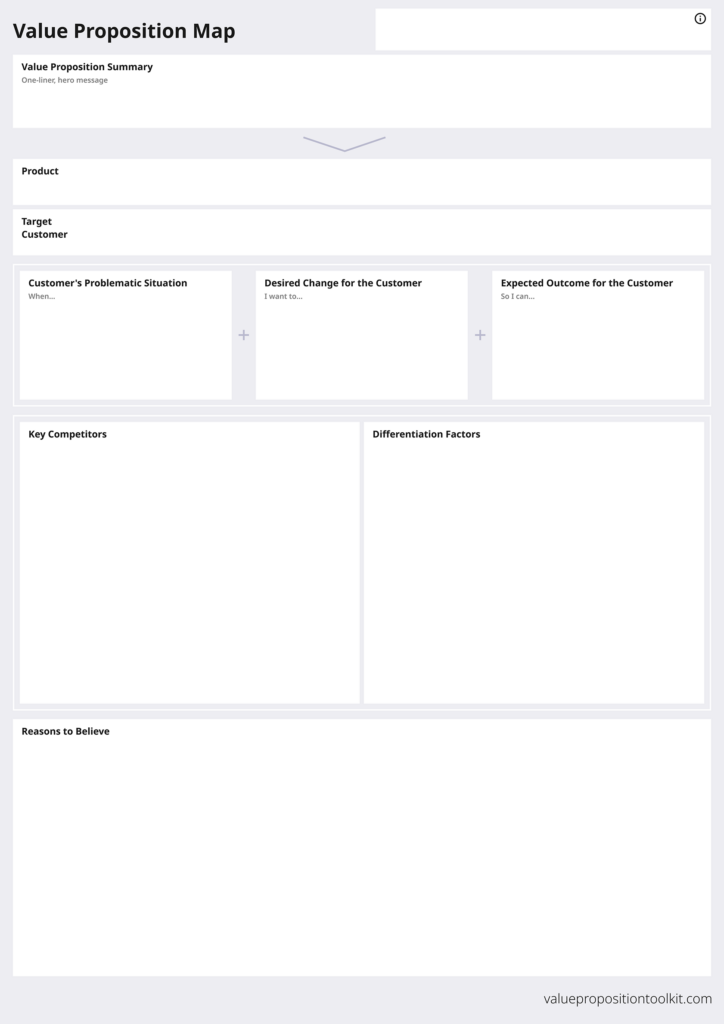
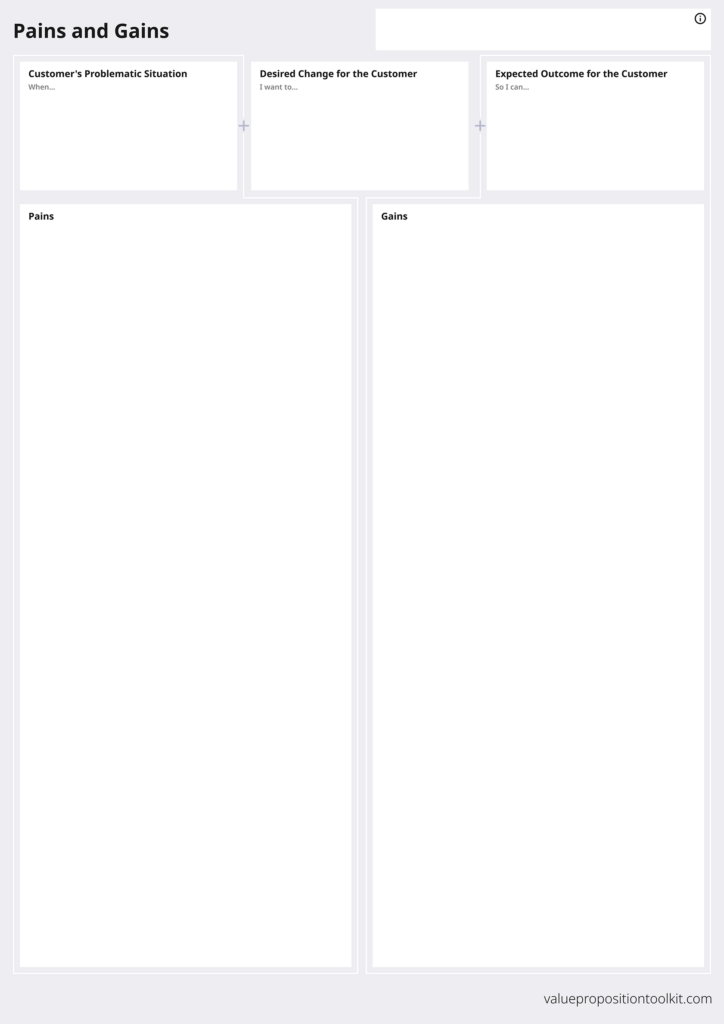
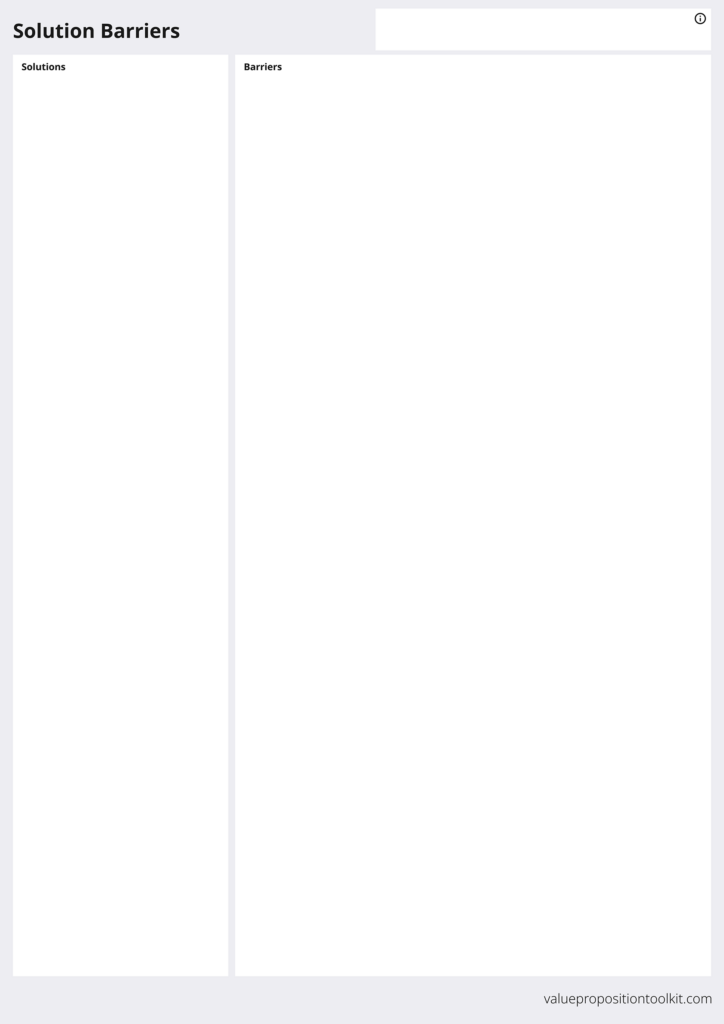
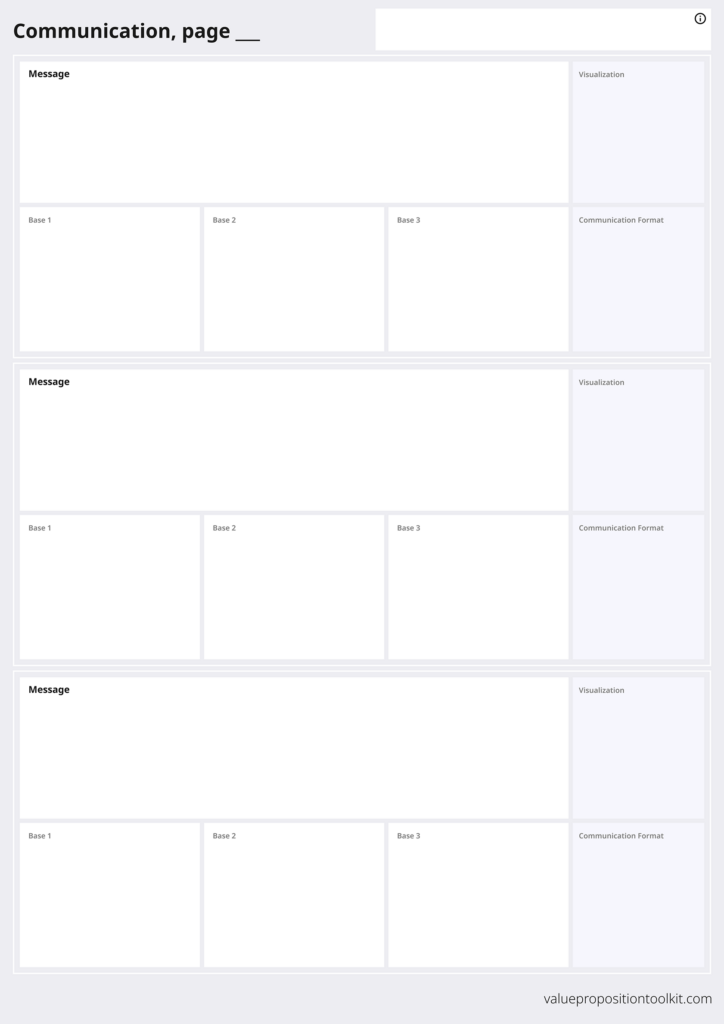
The framework consists of four templates, each serving a specific purpose. Some may argue that this approach is overly complex, as similar methodologies often aim to consolidate everything into a single document. However, I believe it’s preferable to sacrifice aesthetic appeal and superficial simplicity in favor of a more structured, algorithmic approach that yields higher-quality results.
1. Value Proposition Map
This template addresses questions about customers and their needs, the product, value creation, and differentiation from competitors. As the central and most comprehensive template of the methodology, the Value Proposition Map holds significant importance. It encapsulates the product’s value proposition and offers insight even without the use of other templates.
2. Pains and Gains
This template outlines the undesirable situations faced by customers (pains) and the positive benefits they seek when their problems are resolved (gains). It is used in the development of the Value Proposition Map and in crafting communication messages.
3. Solution Barriers
This template describes the obstacles that customers perceive as hindrances to solving their problems through the use of specific goods and services, or certain behavioral patterns. Like Pains and Gains, Solution Barriers are utilized in the development of the Value Proposition Map and in formulating communication messages.
4. Communication
This template consolidates the messages we, as a business, aim to convey to customers so that they understand the product’s value. These messages will later serve as the foundation for marketing materials such as websites, landing pages, presentations, advertisements, publications, sales scripts, and more.
General workflow
Value Proposition Map, Pains and Gains, and Solution Barriers are utilized concurrently, as they interact with one another and share information.

The Communication template should be addressed last, as it synthesizes and formulates information from the first three documents into cohesive messages.
Value Proposition Map
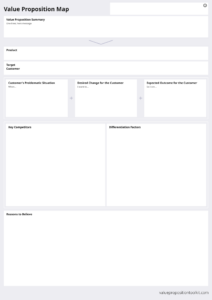
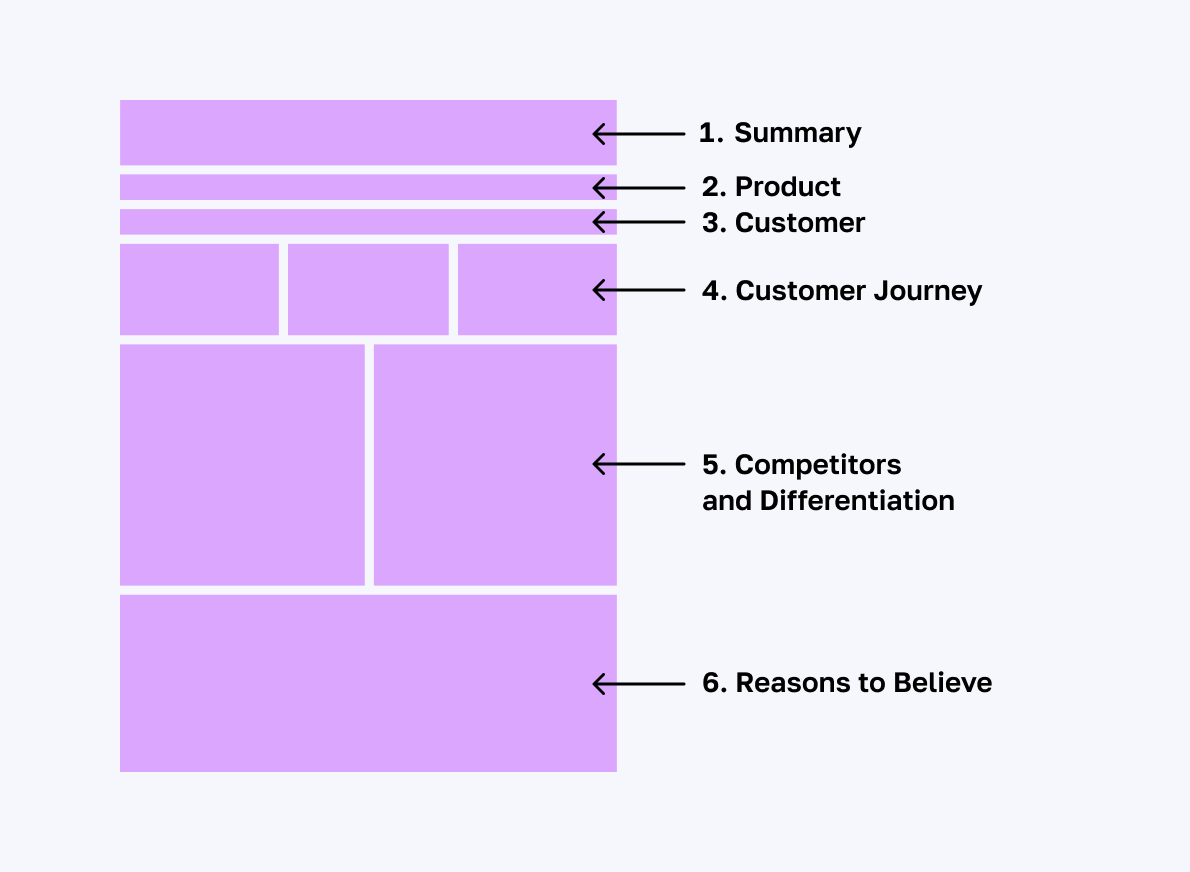
- Start by describing the product (2) with a simple functional description of the good or service in response to the question “What do you sell?”. At this stage, you don’t need to consider the benefits for the customer or package it into marketing messages.
- Think about the customer (3) by identifying who you want as your clients. Answer the questions “Who buys this?” or “Who uses it?”. Keep in mind that buyers and users may differ. Avoid combining multiple target segments within one Map; instead, create a separate Map for each target customer segment.
- Fill in the customer journey (4). Pay close attention as it is one of the most critical components of the Map. The customer journey is based on a job story from the JTBD (Jobs to Be Done) theory using the format “When + I want to + So I can”. Here, you’ll describe the customer’s transition from their current problematic situation to the desired one.
- Identify competitors (5). Classify, group, or highlight the most significant threats, and describe competitive differentiation. Keep in mind that competitors include not only analogous products, but also any solutions (products or customer behavioral patterns) that enable the customer to move from a problematic situation (“when”) to a desired one (“so I can”).
- Incorporate reasons to believe (6), which include product features, facts, and figures that support the statements above, differentiate your product from competitors, address pains and deliver gains (refer to Pains and Gains below), and assist in overcoming solution barriers (see Solution Barriers below).
- Finally, briefly formulate a value proposition summary (1). This can be a one-liner enhanced with a hero message suitable for use on the first screen of a product landing page. Although the entire Value Proposition Map represents the value proposition, use the first field to capture its key essence concisely. Imagine needing to communicate the product’s value to a potential investor with limited characters or time, as in an elevator pitch. Also, consider formulating a condensed version, suitable for the first screen of a landing page.
Pains and Gains
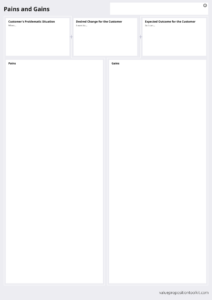
This supplementary tool helps better understand customer needs. It builds upon Strategyzer’s Value Proposition Canvas terminology, but presents the information in a different format.
Pains refer to negative consequences, risks, and other undesired factors that customers face in their current problematic situation. People strive to avoid these pains.
Gains represent the positive outcomes customers seek as a result of resolving their problems. People aim to achieve these gains.
On the left side of the template, list the pains arising from the customer journey, focusing on the “when” aspect of point 3 in the Map. On the right side, outline the gains associated with moving to the desired situation or solving the customer’s problem. This corresponds to the “so I can.”
Prioritize these pains and gains based on their importance to the customer. Then, identify the critical problems your product can solve and the essential benefits it can provide. Determine the specific properties or functions of your product that enable it to address the pains or provide the gains. Include the most crucial pains and gains in the Map and Communication templates. Prioritize those with higher value for the customer and highlight product features that help alleviate these pains or provide these gains.
Solution Barriers

This second supplementary tool concentrates on obstacles, difficulties, and risks (real or perceived) that could prevent a customer from achieving the desired result using a specific solution or group of solutions. These barriers may not be objective but could exist solely in the customer’s mind.
On the left side of the template, list solutions or groups of solutions that can help people move from their current problematic situation (“when”) to the desired one (“so I can”). These solutions represent your competitors, including products and customer behavior patterns. Include your product in this list.
On the right side of the template, identify the barriers corresponding to each solution.
As with pains and gains, prioritize these barriers and determine how your product (with its attributes, properties, and features) can help overcome them. Incorporate this information into the Value Proposition Map and Communication templates.
The emphasis on barriers stems the principle that people often choose the least problematic solutions over those offering the greatest benefits. This hypothesis is based on the loss aversion theory.
Communication
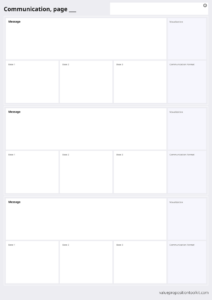
Communication stage uses the work done with the first three templates (Value Proposition Map, Pains and Gains, Solution Barriers) to create messages that effectively communicate to the customer:
- The nature of the problem or pain, underlying causes, and implications.
- How our product helps avoid these problems and deliver gains.
- How our product overcomes barriers associated with competing solutions and the product itself.
Formulate messages that explain the nature of the customer’s problem or pain, underlying causes, and implications.
Craft messages that illustrate how your product overcomes barriers associated with competing solutions and the product itself.
Along with these messages, establish the “bases”—the evidence or reasoning that supports your claims. Decide on the “communication format”—the specific approach to conveying the message to the audience.
Derive these messages and bases from the work done using the Value Proposition Map, Pains and Gains, and Solution Barriers templates.
As a rule, Communication spans 3-5 pages to effectively reflect all the messages needed to convey the product’s value proposition.
It’s not just about the templates
A crucial point to remember is that the value of this framework doesn’t lie solely in the templates themselves.
In fact, if you already have all the necessary information for each section of the templates, you might not even need them.
Instead, you could choose to compile the information in a list or any other format that suits your needs.
Templates serve two primary purposes:
- Provide a structured algorithm and guide research direction when there is no information available or, more importantly, when it’s unclear what information is required. In other words, “templates are nothing; templating is everything.”
- Concisely convey the product’s value. The constraints of templates force us to eliminate unnecessary details and focus on the core essence of the product. This approach proves beneficial in the long run, as it’s much easier for employees, contractors, and partners to study a few structured pages rather than a lengthy, unorganized document.
Templates are nothing; templating is everything.
Incorporating the Value Proposition Toolkit into business practices
The Value Proposition Toolkit has been developed with a primary goal of seamless integration into business processes and operations. Here’s how you can achieve this:
- Stakeholder and contractor communication:
The Value Proposition Map serves as a powerful tool for communicating the value proposition to both internal stakeholders (e.g., employees, management, investors) and external contractors, such as advertising agencies. In some instances, the Value Proposition Map, complemented by the Communication, can even replace traditional briefs. This ensures that everyone involved has a clear understanding of the product’s value proposition and the desired messaging. - Marketing and messaging:
Insights gained from the templates can inform the creation of marketing campaigns and messaging that resonate with the target audience. By emphasizing key differentiators, addressing pain points, and highlighting the benefits provided by the product, this information can be used to craft various marketing materials such as landing pages, slide decks, promotional articles, press releases, and advertisements.
Example application
To better understand the application of this methodology, let’s explore a practical example. In this case, we will develop a value proposition for a fictional eco-friendly, reusable water bottle with a built-in filtration system called “ClearSip.” Please note that this example is simplified and created for illustrative purposes.
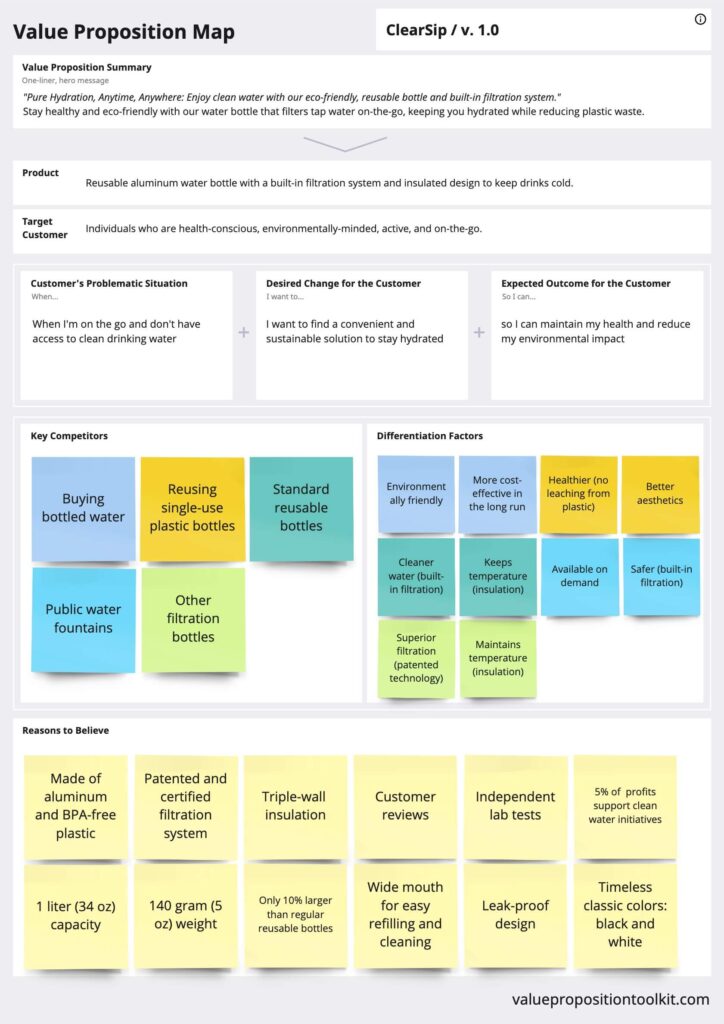
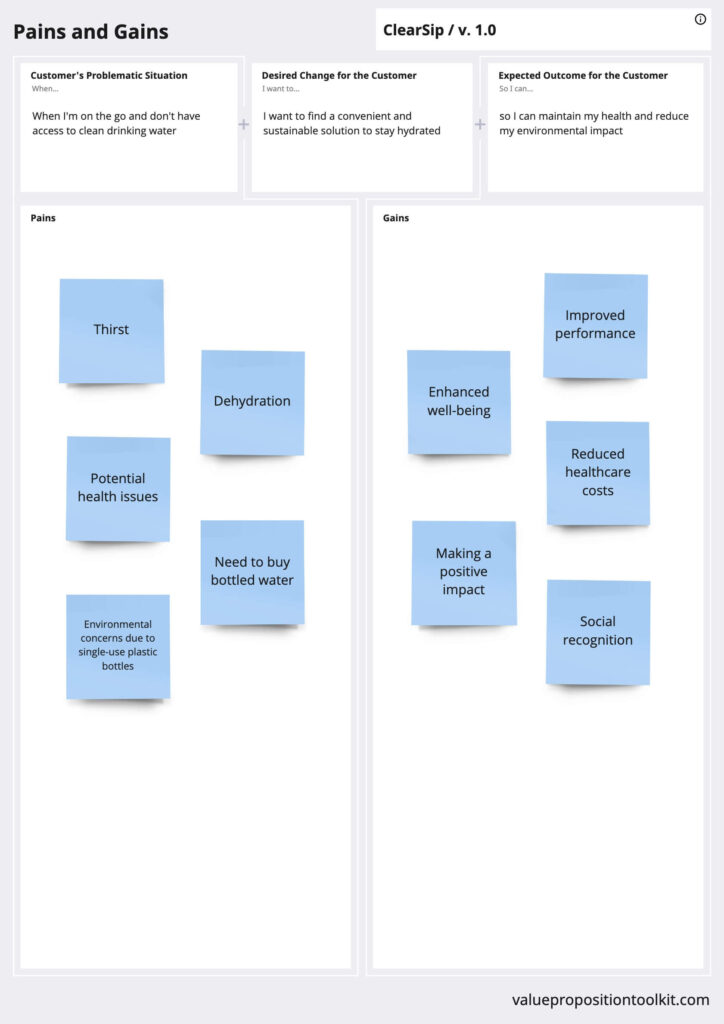

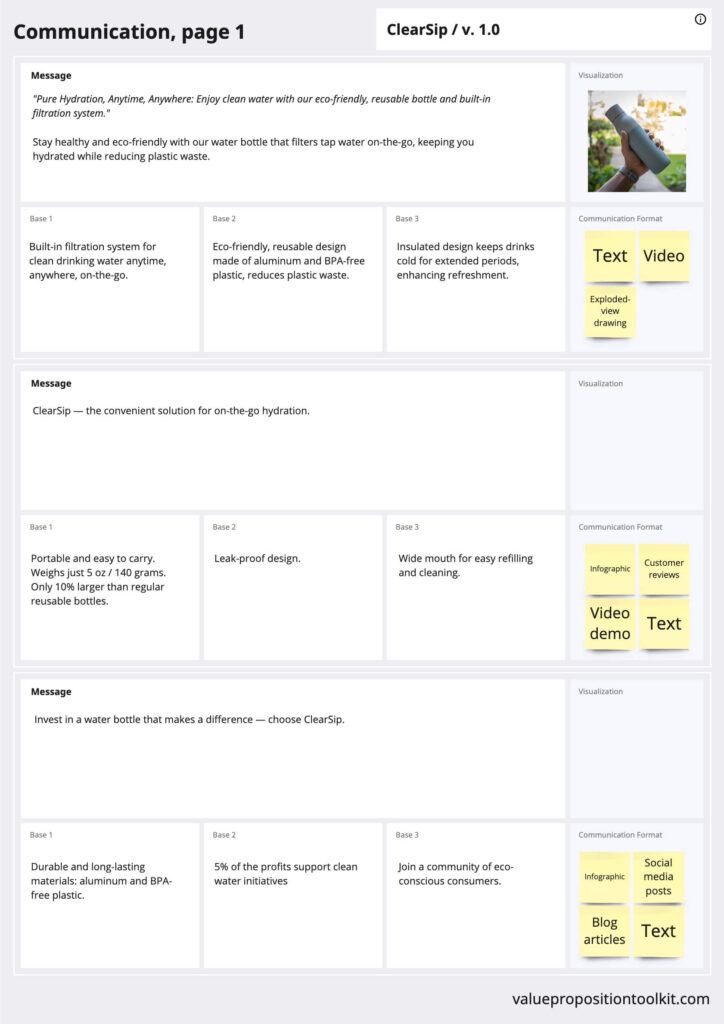
Notes
- It is convenient to use color coding; for example, in the Value Proposition Map, you might use a specific color for “Competitors” and the same color for “Differentiation” to show that this differentiation point relates to this particular competitor or group of competitors.
- Make sure to include your own product in the Solution Barriers template. Remember, your product is just one of the possible options for the customer. This means that, from their perspective, it may also have some barriers. Make sure to consider and list these as well. Don’t forget to address these barriers in both the Value Proposition Map and Communication templates.
- In Communication, we present internal messages that will later be adapted for external use depending on the format of specific materials: one style for a landing page, another for a presentation, and yet another for advertising. Typically, there are three to five pages, rather than just one.
- The “communication format” refers to the manner in which the message is conveyed. Sometimes it needs to be stated explicitly (e.g., “text”). At other times, it’s more effective to communicate implicitly, providing a signal that allows people to form a message in their minds. This approach can create a stronger impression, as individuals draw their own conclusions rather than being told outright.
- Communication should reflect messages that (1) are derived from the first three templates, and (2) address the important needs of customers. Both points are crucial. Not all aspects of “Pains and Gains” need to be addressed, but those significant to the customer should be emphasized. For example, understanding that the target customer will compare our product with the daily purchase of bottled water or traditional reusable bottles means that we need to highlight how we differ and how we are better.
- Messages must be supported by reasons to believe, which we included in the Map in the corresponding section.
Conlusion
Over a span of three years and across dozens of projects, the Value Proposition Toolkit has proven to be an invaluable resource for crafting compelling value propositions. Utilizing its four-step process and supplementary tools, I’ve successfully identified and addressed various aspects of customer needs related to specific products or product categories. This has led to the development of robust value propositions and impactful marketing messages that resonate with consumers, confirming the efficiency of this technique.
If you think the Value Proposition Toolkit is worth exploring, feel free to download the free templates and guides below and incorporate them into your work. I’d be more than happy to answer any questions or address comments you may have about the technique—just drop me a line. Thank you for reading!
PDF templates and a more detailed guide on working with the Value Proposition Toolkit can be downloaded here.